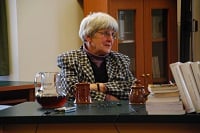Communication with the Dead
A special issue of Religions (ISSN 2077-1444). This special issue belongs to the section "Religions and Health/Psychology/Social Sciences".
Deadline for manuscript submissions: closed (30 March 2024) | Viewed by 2816
Special Issue Editors
Interests: belief narratives; witchcraft; the dead; vernacular religion
Special Issue Information
Dear Colleagues,
Communication with the dead is a rather universal phenomenon of human culture, with many common features but also local, geographical, temporal, and ethnic variations as well as religious differences. In this volume, we aim to expand our current knowledge on communication between the living and the dead by examining the current social embeddedness of the phenomena and new goals and new forms of communication with the dead emerging within new social, public, ideological, and political conditions (wars, migration, political, ideological and religious globalization, new alternative spiritualities, etc.) as well as by presenting case studies from previously unexplored geographical areas (especially, but not exclusively, East-Central Europe).
Authors are encouraged to touch upon a variety of topics, among others on the forms of communication with the dead (dreams, visions, ecstasy, near-death experience, necromancy, private practices and public rituals, ghost walks, legend trips, etc.); the social context of communication with the dead (community of the living and the dead, ancestors and ghosts, time, place, occasions of the communication); specialists (fortune tellers, seers, visionaries, mediums, etc.); aims of communication (providing for the needs of the dead in the afterlife; asking for advice or help to the benefit of individual, family or wider community; divination; gaining knowledge and initiation of healers, soothsayers, and prophets through the dead, etc.), and others. The purpose of this volume is to illuminate the topic of communication with the dead from a multidisciplinary perspective, that is, from the perspectives of a variety of academic disciplines—folkloristics, ethnology and anthropology, history, religious studies, psychology, and others.
We request that, prior to submitting a manuscript, interested authors initially submit a proposed title and an abstract of 400-600 words summarizing their intended contribution. Please send these to the guest editors Éva Pócs (pocseva7@gmail.com) and Mirjam Mencej (mirjam.mencej@ff.uni-lj.si) and to the /Religions/ Editorial Office (coraline.chen@mdpi.com) by 10 September 2023. Abstracts will be reviewed by the guest editors for the purposes of ensuring proper fit within the scope of the Special Issue. You will be notified about the selection by 30 September 2023. If accepted, papers of min. 4000 to max. 20000 words are to be submitted by 30 March 2024. Full manuscripts will undergo double-blind peer-review. The Special Issue will be published by December 2024.
Prof. Dr. Mirjam Mencej
Prof. Dr. Éva Pócs
Guest Editors
Manuscript Submission Information
Manuscripts should be submitted online at www.mdpi.com by registering and logging in to this website. Once you are registered, click here to go to the submission form. Manuscripts can be submitted until the deadline. All submissions that pass pre-check are peer-reviewed. Accepted papers will be published continuously in the journal (as soon as accepted) and will be listed together on the special issue website. Research articles, review articles as well as short communications are invited. For planned papers, a title and short abstract (about 100 words) can be sent to the Editorial Office for announcement on this website.
Submitted manuscripts should not have been published previously, nor be under consideration for publication elsewhere (except conference proceedings papers). All manuscripts are thoroughly refereed through a double-blind peer-review process. A guide for authors and other relevant information for submission of manuscripts is available on the Instructions for Authors page. Religions is an international peer-reviewed open access monthly journal published by MDPI.
Please visit the Instructions for Authors page before submitting a manuscript. The Article Processing Charge (APC) for publication in this open access journal is 1800 CHF (Swiss Francs). Submitted papers should be well formatted and use good English. Authors may use MDPI's English editing service prior to publication or during author revisions.
Keywords
- the dead
- dreams
- ecstasy
- near-death experience
- necromancy
- visions
- rituals
- mediums
- seers
- visionaries
- fortune tellers
- ancestors
- ghosts






